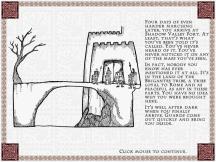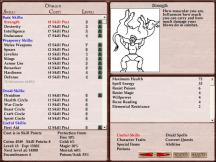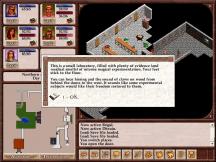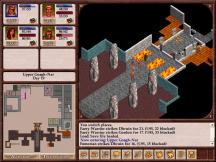Nethergate Resurrection Review
Immersion is a funny word: the dictionary definition is straightforward but exactly what the experience means to any individual gamer can be wildly contrasting. These days, the term is often used to describe the sensory fidelity that accompanies “next gen” graphics and sound but it’s clearly not as simple as that. I remember being completely “immersed” in early text adventures like Zork and The Hitchhiker’s Guide to the Galaxy and the simple wireframe lines of Elite sucked me into a living universe for months. Of course, time and expectations change. Enter Nethergate: Resurrection - the latest old-school CRPG from Spiderweb Games with a rich and immersive world for players that can see past the graphics to the content underneath.
Nethergate: Resurrection is a remake of Spiderweb’s original 1994 title, primarily designed to give new players (and computers) access to the game. I must confess to only having dabbled with the original, so this review will look at the title as it stands rather than comparing to the original.
Nethergate is set in a vaguely historical ancient Britain that sees the invading Romans clashing against the Celts and their mythological milieu. The modern and organised Romans are struggling to contain Boudicca’s rebellion while the Celts are fighting to retain their lands and heritage. Against this backdrop, the player is dropped into an isolated valley named Shadowvale as either a band of young Roman soldiers or fresh Celt warriors summoned by their respective superior to undertake a mysterious mission.
This unusual setting is one of the obvious drawcards. Rather than the usual Tolkien-esque fair, the game is grounded in Celtic mythology with just a dash of historical reference. Players will encounter faeries, witches, druidic hermits and Celtic gods on the one hand and Roman settlements and patrolling centurions on the other. In practice, many of the fantasy conventions remain the same but the different flavour is welcome.
The game opens with the choice of playing either the Roman or Celt campaign (more on this later) and then gives players a standard four person party, which can either be used to jump straight into the action or edited to create your own characters (including removing characters from the party to play with a smaller group or even a “singleton”). From there, a series of stylish black and white panels set the story and the game proper commences. For anyone who has played a previous Spiderweb game (particularly one of the Avernums), most of this will feel familiar even if the details are different.
The second major drawcard for Nethergate is the two separate campaigns – and this has a big impact on the game in a number of ways. Unlike many CRPGs that might offer “paths” through the main quest that really just hinge on a handful of different dialogue choices, Nethergate is split into two completely different (but intertwined) campaigns that together tell the story from two different perspectives. The two sides have different starting points, different quests, a different (though related) story and an emphasis on different character skills.
The story itself is absorbing, with plenty of intrigue and deception as you track down a series of artefacts to help the Celts drive the Romans out of Shadowvale – or, assist the Empire in tightening their grip on the territory. Other groups have their own agendas, and the two stories run in parallel and impact on each other, so you’ll only get the full picture by playing both sides. At times, some events will seem sudden or unexplained and playing the other side reveals the full picture, creating some special moments.
A side effect of this structure is that the main thread is linear, so that the two stories can mesh together – in essence, the two path choices have been made and separated before the game begins. While this may sound like a major drawback, the range of side quests and the richness of the game world help mitigate this issue and I enjoyed the different approach.
Despite the linearity of the main quest, there are quite a few opportunities to make choices throughout the game. For one, as mentioned, there is a raft of side quests to pursue and many of these have choices or different approaches. For example, on encountering a small, poor and barely surviving goblin community, a text box asks if you wish to attack them (they are goblins, after all), approach peacefully or leave them alone - and this decision may affect another seemingly unrelated encounter. In another example, you can choose to support one of two sides in their tit-for-tat hostilities where each believes they have been unjustly attacked. While there are no specific diplomatic or conversation skills to influence outcomes, encounters often incorporate these text boxes with choices for the player. In addition, parts of the main quest have different solutions and your exploration efforts will have a direct impact.
So, exploration. As it turns out, this is Nethergate’s greatest strength. Despite the basic graphics, Spiderweb has created a large, detailed and believable world overflowing with little touches and hidden corners. Shadowvale is brimming with unusual encounters, abandoned guard towers, burial grounds, standing stones with sacrificial altars, civilisations hidden in caverns and hermits in secret alcoves. Some of these are merely cryptic oddities and others lead to side quests or major dungeons. As an example, I encountered a man tied to a stake near the river, close to death. Freeing him, he was too weak to speak but dived into the river - and never reappeared. It wasn’t immediately obvious what had happened and it was quite a while later that I discovered the bigger story. These stories and odd encounters can be found all through Shadowvale.
A small part of the reason this works so well is the different town and world scales used. On exiting a town or dungeon, the game transitions to a zoomed out view, which makes the scale of the world feel bigger while still providing fast travel around the map.
Dungeons play a big role in Nethergate and most of them are large, complex, multi-level affairs. The main quest is essentially a series of major dungeons but there are also a number of optional ones and those related to side quests. Again, these are an explorer’s delight with hidden sections and areas that are difficult to reach. Often you can “solve” the dungeon but miss hidden stashes and even sizeable quests. Nethergate sports different terrain heights (missing in the recent Avernum 4 and Geneforge 4) and this is used to great effect creating complex but believable layouts. If you love hunting down secret doors and ways around magic barriers, Nethergate will be a treat.
Combat has always been prominent in Spiderweb games and Nethergate is no different. The game uses a simple but effective turn-based system that is very similar to other Spiderweb titles, albeit adapted with different skills and a tweak to the Action Point system where an attack can still be initiated with the last AP. This change was also introduced in Geneforge 4 and makes combat more flexible. At it’s best with a mix of party skills and magic against strong opponents the combat is very enjoyable but the lack of active melee skills can make some encounters repetitive, particularly when playing the Roman side.
Nethergate is based on the Blades of Avernum engine from 2004, which we discussed with Jeff Vogel in our recent interview. From a player’s perspective, this is a mixed bag – going back to 800x600 was a real pain and I missed some of the interface improvements from his newer titles. In particular, the quest log is very basic (fortunately you can record messages and dialogue into your own journal) and the minimap can be hard to follow; it’s a good idea to keep some notes as you play because remembering exactly where that hag is on the expansive map is difficult. On the other hand, the terrain height and world travel system from this engine really work.
If you’ve ever enjoyed a Spiderweb game in the past, Nethergate is worth a good look. If you’re new to Spiderweb games but put off by the graphics, ask yourself if the sort of gameplay found in some of the classic RPGs of the past is worth at least playing the demo through. Nethergate may lack the factional choices of Geneforge but the densely packed gameworld is a joy to explore and the story is uniquely told. In considering the score, my personal tilt would be higher but I have to acknowledge the old engine, some interface issues and occasionally mundane combat will be issues for some players.
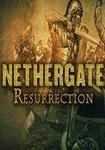
Information about
Nethergate: ResurrectionDeveloper: Spiderweb Software
SP/MP: Single-player
Setting: Fantasy
Genre: RPG
Combat: Turn-based
Play-time: Over 60 hours
Voice-acting: None
Regions & platforms
Internet
· Homepage
· Platform: PC
· Released: 2007-08-10
· Publisher: Spiderweb Software
More information
Summary
Pros
- Fascinating, detailed gameworld
- Good story with two campaigns
- An explorer's dream
- Turnbased combat
- Lots of side quests
Cons
- Aged engine
- Some interface niggles
- Linear main quest
- Combat needs more active skills


